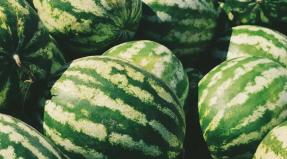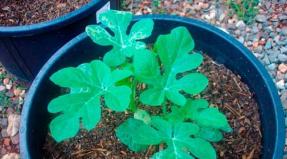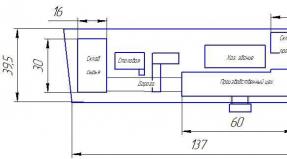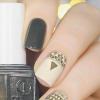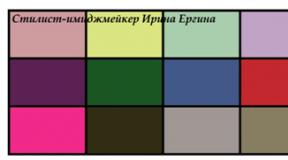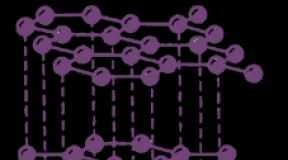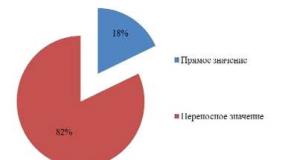Ascaris roundworms. Class Nematoda (Nematoda) Ascariasis message
Vinogradov D.D., Khromova M.R.
General characteristics of roundworms
Nematodes, or proper roundworms (Nematoda), are a type of protostomes, primary cavity, bilaterally symmetrical molting animals.
Building plan. Thin spindle-shaped body, tapering towards the ends, round in cross section. At the front end is the mouth, and at the back is the powder (anus). Outside, the body is covered with a multi-layered elastic cuticle - a non-cellular formation secreted by the hypodermis. The hypodermis, or epidermis, is located under the cuticle. Musculature is represented by a layer of longitudinal obliquely striated muscle fibers. The primary body cavity (schisocoel), devoid of its own epithelial lining, is filled with fluid.
Digestive system. The mouth opening at the anterior end of the body is surrounded by protrusions - lips (usually three) and leads into a muscular ectodermal pharynx with a trihedral lumen. The pharynx leads to the endodermal midgut from a single layer of cylindrical epithelial cells. Next comes the short ectodermal hindgut, which opens into the anus.
excretory system. The excretory organs are unicellular glands that replaced the protonephridia. Usually there is one cervical gland in the front of the body, a short excretory duct departs from it. There are also "accumulation kidneys" - phagocytic organs that accumulate insoluble metabolic products that are not removed from the body.
Nervous system. Nervous system stem ladder type. Represented by the nerve ring and six longitudinal trunks. Two nerve trunks, passing along the abdominal and dorsal lines, are more powerful, connected by semicircular nerve bridges (commissures).
Sense organs. There are papillae and bristles - organs of touch located around the mouth. Some marine representatives found primitive eyes - dark spots. Organs of chemical sense, amphids, usually have the shape of a pocket, spiral or slit. They are located on the sides of the head end and are especially well developed in males, as they help in the search for females.
Reproduction and development. Nematodes are dioecious animals. The internal genital organs are paired, have a tubular structure. Reproduction is only sexual. Sexual dimorphism is pronounced: females are larger, in males the posterior end of the body is bent. Fertilization is internal, live birth occurs. Nematodes in development go through four larval stages, separated by molts, which are accompanied by shedding of the cuticle. The third stage in some species (including the famous Caenorhabditis elegans) under unfavorable conditions is modified into the so-called dauer stage - a resting larva.
human roundworm (Ascaris lumbricoides )
Appearance. The pointed body is pinkish-white. Dimensions: males - 15-25 cm, females - 20-40 cm (Fig. 1). The body is covered with a ten-layer flexible cuticle that protects against mechanical stress and the host's digestive enzymes.
Spreading. The species is cosmopolitan - distributed everywhere, but in different countries different percentages of infected people. In Japan, for example, over 90% of the population is infected with ascaris due to the use of human excrement as fertilizer. In areas with a hot dry climate, roundworm is less common.
Infection occurs by ingestion of eggs with food or water, transmission directly from person to person is not carried out. In the intestine, the larvae pierce the intestinal wall, enter the blood vessels and the liver continue to migrate through the inferior vena cava into the right atrium and right ventricle. From the latter, in the pulmonary circulation, the larvae move to the lungs, where they pass from the blood into the pulmonary vesicles, bronchi, windpipe and oral cavity. Secondary infection occurs in the oral cavity: the larvae are swallowed, enter the intestines and become sexually mature after three months. The process of "growing up" in nematodes is associated with molting (usually there are four of them).
Clinical picture of ascariasis. At the migratory stage of ascariasis, there is a cough (helps the larvae get into the throat), chest pain, allergic reactions, high temperature.
At the intestinal stage, damage to the intestinal mucosa and poisoning of the body with toxic metabolic products occurs. Symptoms: nausea, vomiting, stool disorders, loss of appetite.
Long-term effects of infection: general decrease in working capacity, sleep disturbances. When worms crawl into bile ducts and Airways- fatal outcome. Also, roundworm larvae can enter the brain (for example, from the inferior vena cava to the superior, then along the brachiocephalic), causing meningoencephalitis, accompanied by migraines.
Prevention. Washing hands before eating and preparing food. Washing vegetables and fruits. Eggs are also carried by flies, so that the fight against these Diptera with, for example, Velcro also helps to prevent ascariasis.
Appearance. Grayish-white nematode, males 2-5 mm long, females 8-14 mm. The tail end is pointed (hence the name). At the anterior end of the body, a characteristic swelling of the esophagus is noticeable (Fig. 3).
Crawling out of females is accompanied by itching. When combing the skin, the eggs are transferred to the hands and not only. Flies are also involved in the transfer of eggs. Infection occurs by ingestion. The larvae hatch from the eggs that enter the intestines. Rice. 4. Life cycle of a pinworm
Epidemiology and clinical picture enterobiasis. Enterobiasis is ubiquitous, especially common in children due to non-compliance with the rules of personal hygiene, "crowding" in kindergartens and schools. It is transmitted from person to person without an intermediate host. Reduces the effect of vaccinations.
Symptoms: abdominal pain, loss of appetite, headaches, allergic manifestations, perianal itching (leads to sleep disturbances, increases irritability).
Trichinella (Trichinella spiralis )
Life cycle. For the development of trichinella, a change of owners is necessary. Usually these are wild animals (foxes, wolves, bears, wild boars), as well as people and livestock. Females are fixed by the anterior end of the body into the intestinal epithelium and give birth to 1-2 thousand larvae. Oviparous is characteristic: larvae hatch from eggs in the female genital tract. The larvae are carried through the blood and lymphatic vessels throughout the body and settle in the striated muscles. At this stage, they have a stylet, they destroy muscle tissue with its help, causing the formation of a capsule by the host, in which, having curled up, they remain in the future. After a few months, the capsule is impregnated with lime. Such muscular trichina can exist for several years and survive even after the death of the owner and the decomposition of his corpse.
Once in the stomach of a new host (after eating the corpse of the previous one), the larvae are released from the capsule (Fig. 6.), Penetrate the mucous membrane and within a couple of days, having undergone four molts, turn into adult worms.
Rice. 6. The development of trichinella in the bodyme human
Clinical picture of trichinosis. Fever, puffiness of the face, muscle pain, allergic reactions.
Prevention. Trichinosis is transmitted by food, through infected meat. Therefore, to prevent the disease, the meat must undergo a veterinary examination and be properly cooked - boiled for 2-3 hours. Cooking methods such as smoking and salting do not kill Trichinella.
Vlasoglav (Trichocephalus trichurus )
Appearance. The worm is whitish in color, about 4 cm long (Fig. 7). The front end is thin, reminiscent of hair (hence the name).
Spreading. Prefer countries with a humid and warm climate.
The female lays 1-3 thousand eggs, which enter the external environment with faeces. Like roundworm, whipworm is associated with geohelminths: in order for the eggs to become invasive, they need to stay in the soil at a certain humidity and temperature (25-30 ° C) for a month. After that, infection occurs when the eggs are swallowed, the larvae emerge from them in the host's intestines, penetrate the intestinal villi and grow in them for about a week. Then, having destroyed the villi, they enter the intestinal lumen, reach the large intestine, become fixed there, and reach sexual maturity in a month.
Rishta ( Dracunculus medinensis )
Appearance. Thin whitish nematode (Fig. 9), females 30-120 cm long, males no more than 4 cm. There is a small spike on the tail.
Spreading: tropical countries of Asia and Africa.
Life cycle. Infection occurs when drinking unboiled water with copepods (Fig. 10). Cancers in the stomach under the action of hydrochloric acid die, but the guinea worm larvae survive and are carried throughout the body through the lymphatic system. Then they penetrate into the body cavity, there they molt and reach puberty. After mating, the male dies, and the female moves into the subcutaneous tissue, where a purulent abscess forms, accompanied by burning and pain. Cool water is best for pain relief.
The development of the eggs causes the female to begin to "head" forward to move towards the skin surface, leaving on its way inflammatory process, turning into a purulent abscess, which then bursts. The uterus of the female breaks when it enters the water, and the larvae that hatch from the eggs come out. In order for development not to be interrupted, the larvae must infect the cyclops crustacean, which is an intermediate host. Those larvae that remain in the water die. After swallowing the crustaceans by the final host, under the influence of gastric acid, the crustaceans dissolve, and the larvae easily enter the intestine, make their way through its walls and end up in lymph nodes where the development cycle continues. The disease caused by guinea worm is called dracunculiasis.
Dracunculiasis. Incubation period lasts up to nine months and ends by the time the female reaches puberty. And in a person who has already become ill with dracunculiasis, purulent abscesses begin to form at this time. The only salvation from pain is a pond. The relief is immediate, but during contact with water, the bubbles burst, and the guinea pig throws the larvae into the water. The crustaceans devour them, and life cycle starts again.
In the treatment of dracunculiasis, an incision is often made at the site of the blister and the worm is gradually pulled out, winding it around a stick. This takes days, and sometimes weeks (you have to pull the worm out slowly and carefully so that it does not tear). It has been suggested that the appearance of a rishta wound around a stick became a kind of prototype for the symbol of medicine - the staff of Asclepius entwined with a snake (Fig. 11).
Thread (filiaria) of Bancroft, or Bancroft's string ( Wuchereria bancrofti)
Appearance. White thread-like nematode, females 10 cm long, males - 4 cm (Fig. 12).
Rice. 12. Filaria Bancroft
Spreading. Tropics, subtropics of Asia, Africa, Central and South America.
Life cycle. Adults are commonly found in the lymph glands and vessels, obstructing the outflow of lymph and causing permanent swelling. Females produce larvae - nocturnal microfilariae, which appear at night in the peripheral blood, and during the day they go deep into the body (into the pulmonary vessels and kidneys). This is due to the fact that the intermediate host is mosquitoes, which usually suck blood in the evening and at night. The larvae enter the mosquito's stomach, then into the body cavity, where they grow up, after which they accumulate near the proboscis, from which they are transmitted to humans by sucking blood. Bancroft's threads cause elephantiasis, or elephantiasis, or elephantiasis. It is worth noting that other nematodes can also cause this disease.
Clinical picture and treatment of elephantiasis. There is an increase in any part of the body (Fig. 13) due to hyperplasia (painful growth) of the skin and subcutaneous tissue, which is caused by inflammatory thickening of the walls of the lymphatic vessels and stagnation of the lymph due to clogging of the lymphatic vessels by adults of Bancroft's thread. The skin on the diseased part of the body is covered with ulcers.
Treatment of elephantiasis is aimed at improving the outflow of fluid. Effective use of anthelmintic drugs such as avermectin. In advanced stages, surgery may be required.
Rice. 13. A patient suffering from elephantiasis (according to Brunt)
Bibliography
Dogel V. A. Zoology of invertebrates: A textbook edited by Yu. I. Polyansky. 8th ed. Moscow, 2015.
Hare R. G. USE. Biology in tables, diagrams and figures. 6th ed. Rostov n/a: Phoenix, 2013.
Chesunov A. V. Biology of marine nematodes. M.: T-in scientific publications of KMK, 2006.
According to the structure, roundworms have all the characteristic features.
Ascarids have a spindle-shaped body, males are smaller and have a tail section bent to the ventral side. The male of the human roundworm is up to 20 cm long, the female is up to 35 cm. The diameter usually does not exceed 0.5 cm.
Roundworms are distinguished by the powerful development of the cuticle (10 layers), which performs a protective function from human digestive juices, mechanical damage, and plays the role of the external skeleton.
Ascariasis is distributed almost throughout the globe. In Japan, human excrement is often used as fertilizer, which contributes to the widespread spread of the disease among the population.
Life cycle of human roundworm
Adults live in the human small intestine. Roundworms have separate sexes, fertilization is internal. The female produces more than 200,000 eggs per day, which come out of the host's body.
The eggs are covered with four protective shells. Eggs and larvae in them are able to survive for a long time in extremely unfavorable conditions. However, the development of the larva in the egg occurs only at a temperature of about 25 ° C, a sufficient amount of moisture and oxygen. Under such conditions, after about the 15th day, the egg already contains a roundworm larva that can infect a person. Such an egg is called invasive. The larva in it looks like a small worm.
Human infection occurs through unwashed vegetables, dirty water, due to flies and cockroaches that carry eggs on their paws.
When the roundworm egg enters the host's digestive tract, a larva emerges from it in the intestine, which, with the help of its uncinate process, enters the blood vessels through the wall of the human intestine. With the blood flow, the larva must enter the lungs, since oxygen is needed for its development.
From the pulmonary vesicles, the larvae enter the bronchi, then into the oral cavity of the host, which swallows them again. The larvae find themselves in the intestines for the second time, but now they are already sufficiently developed and turn into adult roundworms.
From infection with an egg to the formation of a sexually mature stage, it takes about three months. After that, in less than 100 days, the worm begins to lay eggs. An adult roundworm lives in the human intestine for about a year.
Ascaris harm
Adult roundworms can cause blockage of the intestine, damage it, and lead to indigestion.
The waste products of ascaris are poisonous, which leads to poisoning of the body, which manifests itself through temperature increase, vomiting, palpitations, etc.
Ascaris larvae, migrating with the bloodstream, can damage internal organs (liver, pancreas), when the larvae pass through the walls of the lungs, blood may appear when coughing.
The structure and systems of organs
1. Ascaris inherent sexual dimorphism The male is one and a half to two times smaller than the female.
2. In the male, the tail is bent to the abdomen, like a comma.
3. Cuticle has a pinkish color, it is translucent, despite the multi-layeredness, and is able to protect the worm well from digestion by enzymes. Beneath it lies a layer of cells hypodermis almost merging into each other.
4. digestive system they begin a mouth, which is surrounded by powerful lips that capture the contents of the host's intestines, and the pharynx. The next segment is the esophagus and midgut, where nutrients are absorbed. hindgut opens to the outside with an anus.
5. Respiratory system no, because roundworm anaerobe. Glycolysis for her is the main way to get energy.
6. excretory system consists of the cervical gland lying in the hypodermis, to which a pair of blind-closed canals approaches.
7. reproductive system females are represented by pairs of ovaries, oviducts, uteruses and a single vagina, which, interestingly, is located on the abdomen closer to the head of the worm. Every day, the female produces at least 200 thousand eggs.
8. The male looks more modest - he has only one testis, a vas deferens and an ejaculatory canal that goes into the hindgut.
Development cycle of human roundworm
1. There is no need to change owners in the life cycle.
2. Fertilization is internal.
3. Eggs mature in the soil, in an oxygen environment, the larva grows inside them for 9–30 days. Therefore, freshly laid eggs are not dangerous for humans, even if they enter the body, ascariasis will not develop.
4. Having reached maturity in the soil, the eggs become invasive - now they are really dangerous for the host. It is not difficult to “catch” an ascaris: it is enough not to wash fruits, vegetables, hands, drink contaminated water, and for children to play in the sandbox and put dirty hands in their mouths.
5. In the intestines of the host, the larvae emerging from the eggs settle down, feed, penetrate through the walls of the intestines into the blood vessels, and then into the liver, heart, lungs ...
6. When the lungs are affected by roundworms, a person inevitably develops a cough. When coughing, the larvae are thrown into the mouth, swallowed again, enter the small intestine and there they reach sexual maturity.
How to avoid infection?
1. Do not forget about the rules of hygiene, wash your hands, vegetables and fruits well. Do not allow children on the street to take fingers, toys into their mouths, lick handrails in transport, etc. Most often, infection with these helminths occurs in the warm season.
2. Control egg vectors such as flies and other insects by covering food.
3. Comply with sanitary standards when organizing garbage pits, toilets - which, of course, is done very badly in our country.
4. Take care of the cleanliness of water bodies.
5. When ascaris is found, be carefully treated - since they can infect the whole family, sexual partner, etc.
2. Trichinella spiralis- infects humans by eating meat with larvae, mainly pork, and pigs become infected by eating sick rats. Inside human body the larvae develop into adult worms, which in turn give birth to live larvae that penetrate the bloodstream and muscle tissue. They are encapsulated in muscles and can stay for decades.
The main habitat is the small intestine. Ascaris has a characteristic feature - a smooth surface of the body. Sexually mature individuals are in constant motion - against the direction of peristalsis and the movement of feces. Attach to walls internal organs, They can not.

What is ascariasis?
be careful
Among women: pain and inflammation of the ovaries. Fibroma, myoma, fibrocystic mastopathy, inflammation of the adrenal glands develop, Bladder and kidneys. As well as heart disease and cancer.
Ascariasis is an anthroponotic disease. That is, the human body is the source, "home" and carrier of worms. The habitat of the roundworm is closely related to the socio-economic indicators of the region. That is, the better and more developed the country, the less problems there are with sanitary and epidemiological conditions. Active manifestation of ascariasis is observed in the distressed countries of Africa. Children are under special attention.
Ascaris infection process
The development of ascaris to a state of maturity occurs already in the body of the person himself. She can get there in one of the following ways:

- through contact of the body with the soil;
- with eating poorly washed vegetables, berries or fruits;
- with the use of tap water;
- with the use of meat and fish dishes that have succumbed to insufficient heat treatment.
Once in the body, the life cycle of the human roundworm passes to the next stage of its own development. There are two of them - intestinal and migratory.
The migration cycle of roundworm development occurs with the help of the circulatory system. With the blood stream, the larvae are transported to the liver, then to the heart and lungs. After that, they fall into the throat. And this is again a direct path to the intestines. There is a secondary ingestion of the larva, which, getting into the intestine, develops into a sexually mature individual.
- weaknesses;
- chronic fatigue;
- pain in the intestines;
- severe cough (especially at night);
- anemia;
- digestive disorders.
Ascariasis in adults can pass without noticeable symptoms. Rarely, additional symptoms appear. Ascaris symptoms in adults are also manifested in the form of: headache, nervousness, jumps in heart pressure, sleep disturbances, internal bleeding and drastic weight loss.

From whom:

For the last few years I have felt very bad. Constant fatigue, insomnia, some kind of apathy, laziness, frequent headaches. I also had problems with digestion, in the morning bad smell from mouth.
And here is my story
All this began to accumulate and I realized that I was moving in some wrong direction. began to lead healthy lifestyle life, eat right, but it did not affect my well-being. The doctors couldn't say much either. It seems like everything is normal, but I feel that my body is not healthy.
A couple of weeks later, I came across an article on the Internet. literally changed my life. I did everything as it is written there and after a few days, I felt significant improvements in my body. I began to get enough sleep much faster, the energy that I had in my youth appeared. The head no longer hurts, there was clarity in the mind, the brain began to work much better. Digestion has improved, despite the fact that I now eat haphazardly. I passed the tests and made sure that no one else lives in me!
- bile ducts and gallbladder;
- liver;
- pancreatic ducts;
- heart;
- lungs;
- stomach.
Diagnosis of ascariasis
Treatment of ascariasis in adults is prescribed only according to the results of the following studies:
It is also important to take into account the anthropometry of the patient. This is especially true for children. Measurements are taken from the patient:
- growth;
- weight;
- head circumference;
- chest circumference.
The internal structure of roundworm is a complex biological mechanism that produces enzymes that adversely affect human health. And if, according to the results of the study, antibodies to these toxins are detected, then there is only one conclusion - the person suffers from ascariasis.
Serological research methods include:
- immunofluorescent study;
- erythrocyte sedimentation reaction;
- agglutination reaction with carmine;
- ring precipitation reaction;
- precipitation reaction;
- bentonite flocculation reaction.
These studies, as well as a description of the picture of the disease with their help, are considered effective by doctors, only in the early stages of ascariasis.
Sputum analysis for roundworms
If the attending physician suspects that roundworms have entered the respiratory organs, then he directs the patient to a sputum examination. The main condition is a "wet" cough. The meaning of such research lies in microscopy. With a multiple increase, helminth larvae can be seen in the sputum.
There is also an option for those patients whose sputum does not go away by itself. In such cases, lavage is done - washing the bronchi during an unpleasant procedure for the patient - bronchoscopy. But this research method is rarely used.
Analysis of feces for roundworms

Urinalysis for roundworms
Radiography and ultrasound
Complications with ascariasis

Complications also include: cholangitis, peritonitis and inflammation of the appendix. Each of these diseases has its own symptoms. With complications of ascariasis, a person feels severe attacks of pain in the intestinal or abdominal cavity. When they appear, you should immediately consult a doctor.
This danger is due to the large size of helminths and their excessive active life. That is, if a person feels the symptoms of the disease, he should immediately consult a doctor. If ascariasis appears in adults, the symptoms and treatment are interrelated. And only qualified specialists can identify the risk of certain complications, as well as prescribe effective treatment.
Treatment of ascariasis
There are several options for how to get rid of worms. The first is the treatment of ascariasis by methods traditional medicine, and the second one with folk recipes. But when it appears acute symptoms, it is better to go to the hospital. After all, they can lead to serious diseases.
Death from roundworms is rare. A lethal outcome is possible only in case of serious complications. The risk of death increases many times if the patient is not given timely medical care. A lethal outcome is possible with complications of helminthic invasion, which include: pneumonia, asphyxia, pancreatitis and purulent cholangitis.
Drugs used for ascariasis

The following anthelmintic drugs will relieve the patient of ascaris:
- albendazole;
- Decaris;
- Vermox;
- Helmintox;
- Wormil.
Treatment differs between adults and children, often due to the excessive toxicity of drug components. Children are most often prescribed decaris, pyrantel and vormil.
Treatment of ascariasis folk remedies
How to remove roundworm? This question is relevant for anyone who wants to get rid of helminths. Recipes can help with this:
- infusion of garlic and horseradish;
- infusion of wormwood;
- onion infusion;
- garlic solution in milk.
- decoction of tansy.

There are many options on how to get rid of ascaris. The most effective in the fight against helminths is garlic. The recipe for making "garlic solution in milk" is simple. One head of garlic is boiled in a glass of milk for 5 minutes. After that, it is taken out, crushed and put back. The resulting remedy is used for enema - 1 time per day before bedtime.
Treatment for ascaris is also effective with the use of infusion with pumpkin seeds and wormwood. The components are taken in equal parts and pour 1:3 vodka. After that, the mixture is settled for 7 days. Ascaris does not tolerate such treatment, and when taken 50 grams half an hour before each meal, it dies and leaves the body.
Preventive measures
How to treat ascariasis in adults and children? This question is becoming more and more relevant. According to the Ministry of Health, a quarter of the world's population is already susceptible to such helminthiasis. And the most appropriate healthy person, pay attention not to "what to treat." It is better to try to prevent ascariasis. It is not difficult to do this. The main thing is to follow the following rules:
- Wash hands thoroughly before eating, after contact with animals and walking outside.
- Regularly take stool and urine tests, as well as visit a doctor. Early detection of the disease is the first step to a quick cure.
- Thoroughly wash vegetables and fruits before eating (it is better to scald with boiling water).
- Drink only purified boiled water.
- Fight insects. They are carriers of helminth eggs.
But if it was not possible to protect oneself from helminthic invasion, it is urgent to contact infectious disease doctors who will provide qualified assistance in the treatment of ascariasis. Self-medication is dangerous, especially when the patient shows symptoms toxic action helminths.
The color of this helminth is reddish, after death the color changes to white with a yellow tinge. The body is spindle-shaped, elongated, gradually tapering towards pointed ends. It consists of a cuticle - the outer shell, and a cavity. The cuticle consists of ten balls of epithelium. Its main task is to protect the worm from chemical influences carrier digestive enzymes, toxic substances as well as mechanical damage.
The digestive system begins with the mouth, which is surrounded by three sensitive papilloma lips. Food through the mouth enters the tubular intestine, where all the nutrients are absorbed. Undigested residues are excreted by the anus, which is located at the end of the body.
The body cavity of the roundworm is a kind of ectoderm bag filled with liquid. It is very strong, resilient and has the role of support for the muscles. The muscles are longitudinal, separated from each other by the hypodermis and located along the walls of the body. Such a special structure of the musculature does not allow the worm to shorten or lengthen, therefore, to advance, the worm bends, staying on its side.
The nervous system is expressed by a peripharyngeal ring and nerve trunks that run along the entire body of the worm.

Organs of attachment of the human roundworm are absent. Worms are constantly moving towards stool due to which they are retained in the intestines.
Roundworm eggs begin their development after entering the soil along with feces. The maturation of the larvae in the egg should be facilitated by access to oxygen, as well as the optimal air temperature - up to 25 degrees Celsius. The larvae enter the human body along with unwashed vegetables, fruits and garden greens. People who work in vegetable gardens, greenhouses, orchards, as well as children, suffer the most from roundworm infection.
Ways of transmission and infection of ascariasis
Transmission of ascariasis occurs from person to person. But it is impossible to get sick from contact with the patient. This is evidenced by the life cycle of the human roundworm. Helminth eggs can only be infectious if they have matured in the ground. They also need a certain temperature and humidity for their development. Temperatures above 50 degrees and below 30 degrees Celsius are fatal for roundworm eggs.
Ascariasis disease occurs in countries where a warm and humid climate prevails. In polar regions or deserts, helminths cannot reproduce and survive due to unacceptable climatic conditions for them.

The cycle of development of the human roundworm contains two stages.
Migration stage
Upon entering the small intestine, the larvae are released from the shell. Their size is 0.2 mm. With the help of hook-shaped processes, they pierce the intestinal mucosa and penetrate into the blood.
Moving across circulatory system, the larvae move into the human organs (heart, liver), after which they go to the lungs. In the alveoli, the larvae pass through two stages of molting. Their size becomes already 1.4 mm. To continue to develop, the larva has to move towards the larynx, passing through the bronchi and trachea.
The larva irritates the respiratory tract and causes a cough that facilitates its movement. The final point of migration is the intestines, in which the larva will turn into an adult worm.
Stage intestinal
In the intestine, the developing roundworm feeds on blood serum and continues to grow. Until the moment when the larva turns into an adult and begins to lay eggs, 80 days pass. The female helminth can reach 40 cm in length, which is almost twice as long as the male.
The human roundworm feeds on the blood of the patient, gradually absorbing from small intestine useful material. Therefore, the first symptom of roundworm infection is weakness and general malaise.
Often it is impossible to detect the presence of worms in the body in the first stages of the disease, since they do not manifest themselves in any way. The main symptoms can be noticed already when the infection of the lungs has occurred. They can be confused with signs of bronchitis or pneumonia due to their similarity.
List of the main symptoms of infection of the lungs with roundworms:
- Constant fatigue, loss of strength, weakness;
- sudden rise in body temperature. More often seen in children. Less common in adults;
- shortness of breath, shortness of breath;
- cough. May be dry or mucus. Frequent bouts of coughing in the morning;
- headache, dizziness, nausea, blurred vision;
- rapid weight loss and decreased appetite;
- skin rashes, allergic reactions;
- pain in the chest;
Symptoms of the presence of human roundworm in children on early stage may manifest as decreased appetite, prolonged cough, urticaria, itching, as well as nausea and vomiting. Often in children, the first sign of the disease is diarrhea, as well as enlarged lymph nodes.
In most cases, the child noticeably decreases activity, he becomes inattentive, refuses to eat. When the disease passes to the second stage, bloating and flatulence appear, the skin becomes pale, some of the symptoms worsen, the child loses weight. Roundworms reduce immunity, intoxication of the body begins.
With further reproduction of ascaris, signs of infection appear more and more. To the above symptoms are added muscle pain, strong sweating. It is also possible to observe high blood pressure and palpitations. When the reproduction of the worm develops into a mass one, a person may develop severe allergies and even anaphylactic shock. Pain in the stomach, vomiting, diarrhea - all these are signs of a very serious illness, in which the help of a specialist is required.
The first step in the diagnosis is to collect information about the symptoms that bother the patient. Further, using microscopy, the presence of helminth eggs in the feces is diagnosed. In photographs of a human roundworm in feces, the eggs look about the same as in the laboratory under a microscope.

The reasons why eggs were not found in the feces, but helminth disease is possible:
- The man was recently infected, and the female had not yet had time to lay her eggs;
- ascariasis in a patient in an extraintestinal form;
- eggs are absent only in the feces intended for analysis.
In such cases, other diagnostic methods are prescribed - a blood test, tomography, ultrasound, radiography.
Prevention of infection with human ascaris
The main rule for the prevention of infection with ascariasis is to prevent the entry of helminth eggs into the body. Personal hygiene is one of the most simple ways keep away the worms.
Personal hygiene as a fight against roundworm infection
- Timely cutting of nails;
- change of bed and underwear;
- the washing up fresh vegetables and fruits;
- proper heat treatment of meat and fish products;
- the use of gloves while working in the garden or garden;
- washing hands with soap or using antibacterial agents after walking outside;
- individual cutlery and personal hygiene products for each family member;
- frequent disinfection in common areas, wet cleaning;
- pet care, timely vaccination and deworming;
Even if all these rules are observed, no one is immune from the defeat of worms. You can become infected with ascariasis even while swimming in the lake, as there are usually a large number of helminth eggs in the water. Therefore, at the first suspicion of the possible presence of ascaris in the body, it is necessary to consult a doctor and carry out therapy. medicines according to the written prescription.
anthelmintic drugs in modern world There are many and in most cases improvement occurs after the first medication. Only a specialist can determine the necessary remedy, based on the severity of the disease, age, weight, and also the tendency to allergic reactions.
Depending on the stage, the drugs of first choice are different. For example, in the migration stage, agents based on mebendazole, levamisole or thiabendazole are used. They possess a wide range actions. In the intestinal phase - Piperazine, Mebendazole, Pirantel.
After taking medications, it is recommended to take enterosorbents - to remove from the body toxic substances. And for the speedy recovery of health, it is recommended to take a vitamin-mineral complex, as well as enzyme preparations prescribed by the attending physician.
